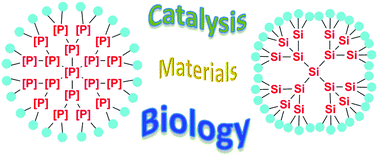Inorganic dendrimers: recent advances for catalysis, nanomaterials, and nanomedicine
Abstract
Dendrimers are hyperbranched polymers having a perfectly defined structure because they are synthesized step-by-step in an iterative fashion, and not by polymerization reactions. Some dendrimers are considered as inorganic, as they possess inorganic atoms at each branching point. Among numerous examples, two families of inorganic dendrimers have emerged as particularly promising: silicon-containing dendrimers, particularly carbosilanes, and phosphorus-containing dendrimers, particularly phosphorhydrazones. This tutorial review will display the main properties of both families of dendrimers in the fields of catalysis, materials and biology/nanomedicine. Emphasis will be put on the most recent and promising examples.

- This article is part of the themed collection: Smart Inorganic Polymers

 Please wait while we load your content...
Please wait while we load your content...